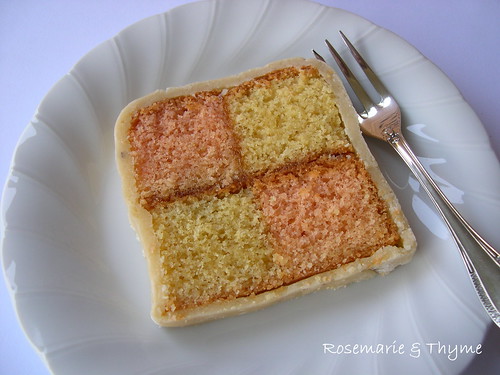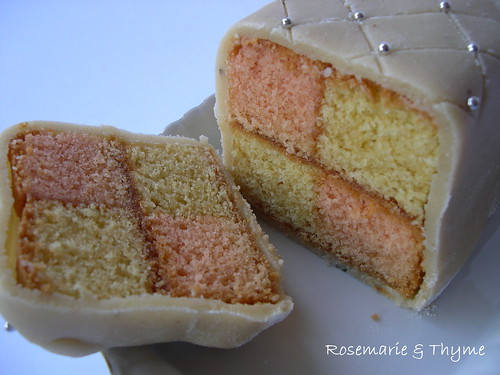Questo mese la Vitto ospita L'MTC , in qualità di vincitrice dell' MTC di luglio 2012.
Io e la mamma di mio marito oggi abbiamo fatto la torta Pasqualina insieme per la prima volta. E ci siamo divertite molto. Due donne in cucina, quando c'è sintonia, lavorano bene, velocemente, anticipano l'una i bisogni dell'altra e in un battibaleno il piatto è pronto. Solo un attimo di sconcerto quando non trovavamo le cannucce (con il gomito come consiglia la Vitto) ma poi sono saltate fuori. Fiuuuuuu. :))) e non solo in senso figurato.
Ovviamente quando mia suocera mi ha visto arrivare a casa sua con la mia spianatoia lì per lì è rimasta interdetta ... lei ce l'ha la tavola per impastare!!! Ma chiarito che la mia l'avevo portata per usarla come ripiano per le foto, la serenità ha continuato a regnare in cucina :)) D'altronde con tutti i raviêu (trad. ravioli), le torte pasqualine a gogo, mandilli de sea (trad. fazzoletti di seta o lasagnette) e pizze ripiene che vengono preparate, chi poteva dubitare?
Gli accordi li avevamo presi già da prima, io arrivavo, di corsa, con la maggior parte degli ingredienti maggiorana inclusa!, perchè mia suocera alle sue piante aveva chiesto già troppo , assemblavamo il tutto con tanto di servizio fotografico e poi io tornavo a casa, seeempre di corsa, con la teglia da infornare e fotografare prima del buio ; )
Che dire...intanto, abbiamo seguito la ricetta, pesando ad occhio gli ingredienti, eh,eh! C'è chi può! (Non io, si intende) E l'impasto è venuto perfetto. Come ha detto la Vitto , niente manitoba, perchè 100 anni fa non c'era. Un solo cambiamento, niente sale, perché mia suocera non lo mette. Dice che la pasta rimane più croccante senza. Sarà perché il sale assorbe l'umidità, giusto? E qui si potrebbe già iniziare a disquisire. Dariooooo dove sei? Confermi? Smentisci?
Ci siamo date il cambio nella lavorazione dell'impasto, intanto le bietole ormai cotte sono state scolate ben bene, poi tritate sul tagliere con la mezza luna, unite al trito e passate in padella. C'era un pezzettino di dado che spuntava lì sotto al trito, ma non lo dite a nessuno. Io non l'avrei messo...perché ho abolito il dado da anni. Ah, dimenticavo noi a Roma, niente prescinseua. Stracchino. Ma ho raccontato a mia suocera che la Vitto consiglia lo yogurt greco con la ricotta ed abbiamo deciso che la prossima volta facciamo una degustazione di torte Pasqualine e decidiamo quale ci piace di più.
Pennello per ungere la pasta? Naaaaaa. Probabilmente noi con l'olio, quindi, abbiamo abbondato, ma diteci voi. Le foto son proprio qui sotto.
La chicca?
Il mattarello. Non è un mattarello. Proviene dal negozio di Odone che era in Via Luccoli, dove teneva la contablità la nonna Iside, la nonna paterna di una nostra cugina. Serviva per arrotolarvi la seta. Troppo forte, no? E devo dire che è perfetto per stendere un impasto lasciandolo leggermente ruvido.
Abbiamo deciso per una sfoglia sotto un po' più spessa e quattro sopra che secondo me, vedendo la foto della Pasqualina della Vitto, dovevano essere più sottili. E come avete visto il ripieno non è a strati nella famiglia di mia suocera. Quindi mi incuriosisce molto la versione sempre della Vitto a strati. Nonché tutte le notizie di ripieni "alternativi", in particolare con la zucca. Vittoria ti contatterò per saperne di più.
P.S.
Per la fetta tagliata dovete attendere domani. Stasera dovevamo finire di mangiare l'Empanada Gallega di ieri (vedi post precedente) e la Pasqualina si doveva raffreddare e soprattutto insaporire. Verrà addentata domani.
Complimenti a tutti, dopo aver postato ho dato una prima sbirciata e ci sono delle idee strepitose.
P.S.
Per la fetta tagliata dovete attendere domani. Stasera dovevamo finire di mangiare l'Empanada Gallega di ieri (vedi post precedente) e la Pasqualina si doveva raffreddare e soprattutto insaporire. Verrà addentata domani.
Complimenti a tutti, dopo aver postato ho dato una prima sbirciata e ci sono delle idee strepitose.
Ecco che cosa ci ha scrittoVittoria:
"Tutti possono cimentarsi in questa prova, il mattarello già lo abbiamo usato, la tecnica di tirare la sfoglia con i pugni infarinati si impara in fretta. Il segreto sta nel far riposare la pasta e nel non farla troppo dura.
La manitoba non è indispensabile (100 anni fa non c’era di sicuro) ma aiuta un po’ a evitare i buchi nella pasta quando si tira. Quindi vi aspetto a pugni infarinati e fantasia scatenata.
Piatto apparentemente semplicissimo nella povertà degli ingredienti, diventa una poesia di sapori e profumi che si sprigionano al taglio e ad ogni morso. Perfetta alternanza di consistenze (croccante, morbido, pastoso) e di colori (bianco, verde, giallo). Ho verificato sul campo una volta di più che non si può smettere di mangiarla. Vi prego solo di farla raffreddare perché se cercate di tagliarla e gustarla appena uscita dal forno resterete delusi: la pasta si sfalda, il ripieno troppo caldo non esprime sapori, ma bruciori. Aspettate almeno che sia tiepida!
La Pasqualina, rigorosamente di bietole (a Pasqua i carciofi non ci sono o sono cari, i genovesi…maiiiii) è la torta salata ligure più famosa, ma le varianti sono moltissime, praticamente con ogni verdura ed erba disponibile
Io vi propongo 2 versioni.
La prima è la Pasqualina più antica dove le bietole, il formaggio, le uova, non sono mescolati insieme, ma assemblati accostati, si mescoleranno solo in bocca regalandovi una gran differenza di sensazioni. Il formaggio utilizzato è la Prescinseua, la quagliata genovese, introvabile altrove, si può provare a sostituirla con un misto di ricotta e yogurt greco..oppure dovrò aprire uno spaccio di prescinseua.
La seconda è detta torta cappuccina; bietole e ricotta sono mischiate in un composto comprendente anche uova. Il sapore è diverso ma ugualmente squisito.
Poi ci sarebbe la versione “ricca” ai carciofi o un misto di bietole e carciofi, poi cipolle, zucca, zucchine o zucchine trombetta, patate, funghi, ecc…. ma noi ci fermiamo alle prime due.
Per le note storiche vi rimando a un bellissimo post della Dani pubblicato ad aprile su Menuturistico
TORTA PASQUALINA DELLA MILIA
La Milia era la tata di mio papà che avrebbe 84 anni, quindi la ricetta ne ha 100 almeno almeno. Mio padre ne parlava con grande affetto e rispetto. Lei non sapeva leggere e scrivere quindi la ricetta è stata trascritta da mia nonna sul suo quaderno nero e a me è arrivata con una copia (sempre scritta a mano) che una zia aveva fatto per ogni sorella o fratello in modo che ognuno avesse la sua.
Pasta: Impastare 300 gr di farina “0” (meglio manitoba regge meglio quando si tira sottile) con sale, 30 gr di olio, ½ bicchiere di vino bianco secco e circa ½ bicchiere di acqua bastante per una pasta morbida (circa 150 gr di liquidi), ma non appiccicosa. Dividere in 5 palline e fare riposare coperta almeno 1 ora, meglio 2.
Pulite 1,2 kg di bietole, togliendo quasi tutta la parte del gambo, tagliatele a striscette e saltatele in padella con olio e.v.o. maggiorana e cipolla tritata. Deve asciugarsi bene l’umidità. Lasciare raffreddare.
In una ciotola lavorate 250 gr di “prescinseua” genovese con 50 gr circa di parmigiano grattugiato, un pizzicone di maggiorana, sale e pepe.
Stendete una pallina in una sfoglia sottile e foderate il fondo e le pareti di una teglia tonda (diametro 22-24) unta d’olio facendola un poco debordare (ungete anche il bordo della teglia altrimenti la pasta si strapperà quando dovrete arrotolarla) Ungete la pasta di olio con il pennello, stendete la seconda sfoglia. Versate dentro le bietole, sopra il composto di formaggio.
Poi con il dorso di un cucchiaio fate 3 o 4 incavi a distanza regolare e in ognuno rompete un uovo; salate e pepate e versate un filino d’olio su ognuno. Le altre 3 sfoglie devono essere tirate sottilissime e non devono assolutamente avere buchi; io le tiro prima con il matterello e poi mi aiuto allargando la sfoglia con i pugni infarinati e ruotandola (non è facile farlo senza bucare la sfoglia).
Tirare la prima delle tre sfoglie e coprire il ripieno facendo debordare la sfoglia di lato. Ungere bene la superficie con un pennello o con le dita delicatamente (sotto ci sono le uova intere!!!). Appoggiare la seconda sfoglia, ungere bene, appoggiare al bordo una cannuccia per soffiare aria fra uno strato e l’altro di pasta del coperchio, appoggiare l’ultima sfoglia e ungete anche questa molto bene. A questo punto arrotolare il bordo a cordoncino (se è troppo tagliarne una parte con le forbici).
Se usate una cannuccia con il gomito non ci sarà rischio che qualche micro goccia di saliva arrivi alla torta, terrore di molti!!! Una volta si usava un maccherone lungo!
Quando è ben gonfia come un palloncino togliete rapidissime la cannuccia e sigillate l’apertura.
Infornare a 180° per 40-50 minuti o fino a doratura della pasta.
Appena tolta dal forno spennellate delicatissimamente di olio. Raffreddandosi la pasta si ammorbidirà e, se l’avrete fatta abbastanza sottile, scenderà come un velo!
TORTA PASQUALINA DI NONNA IBIDI
Stesse dosi per la pasta, la verdura e il formaggio (ricotta o prescinseua); per questa ho usato ricotta.
Una volta cotte le bietole, preparate l’impasto di ricotta, parmigiano, pepe, sale, maggiorana e aggiungete anche 2 uova battute. Tritate grossolanamente a coltello le bietole quando sono fredde e aggiungetele ai formaggi.
Ungete la teglia, tirate e sovrapponete le prime 2 sfoglie, versate il ripieno. Poi procedete come per l’altra torta: fate le fossette, sgusciate le uova, tirate le altre 3 sfoglie ungendo fra una e l’altra, chiudete il bordo a cordoncino, gonfiate la sfoglia a cupola, infornate."






















